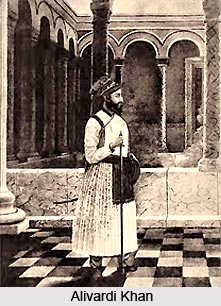 Alivardi Khan came to power after defeating Sarfaraz Khan in the battle of Giria. He had overthrown the Nasiri Dynasty. He ruled from 1740 till 1756. Born on 10th May 1671, he was named Mirza Muhammad Ali, the son of Shah Quli Khan Mirza Muhammad Madani. Alivardi Khan was the founder of the Afshar dynasty.
Alivardi Khan came to power after defeating Sarfaraz Khan in the battle of Giria. He had overthrown the Nasiri Dynasty. He ruled from 1740 till 1756. Born on 10th May 1671, he was named Mirza Muhammad Ali, the son of Shah Quli Khan Mirza Muhammad Madani. Alivardi Khan was the founder of the Afshar dynasty.
Alivardi Khan`s father Mirza Muhammad Madani served as an employee to Azam Shah the son of Mughal emperor Aurangzeb. After the death of Azam Shah, the family fell into poverty and Alivardi Khan came to Delhi and passed his days in extreme deficiency, often going without a meal. It was Shuja- Ud- Din Muhammad Khan who bestowed him with the title of Alivardi. Alivardi Khan advised him on the kingdom`s administrational and financial matters. He was then chosen as the deputy Nazim of Bihar in 1733, and was later entitled Mahabat Jang, for his brilliant economic reforms and efficient management skills in the ruling of Bihar.
In the year 1740 he defeated Sarfaraz Khan in the battle of Giria and became the Nawab of Bengal. He was recognized by the Mughal Emperor Muhammad Shah and was endowed with several titles like Shuja-ul-mulk and Husam-ud-daula. He was an able administrator and defended his territory from the enemies. As the Marathas invaded frequently it brought a major slow down in the region`s trade, agriculture and financial system. Under his dominion Bengal was twice attacked by the Nagpur kingdom by Raghoji Bhonsle in the year 1746 and 1750. He signed a peace treaty for war indemnity with the Marathas in 1951. Alivardi khan put up a brave fight against the Afghan invasions and this took a heavy toll on his health. Alivardi Khan nominated his grand son Siraj-ud-daula to be his heir. Alivardi died in the year 1756 and Siraj-ud-daula succeeded him as the next ruler.
This article is a stub. You can enrich by adding more information to it. Send your Write Up to content@indianetzone.com



















